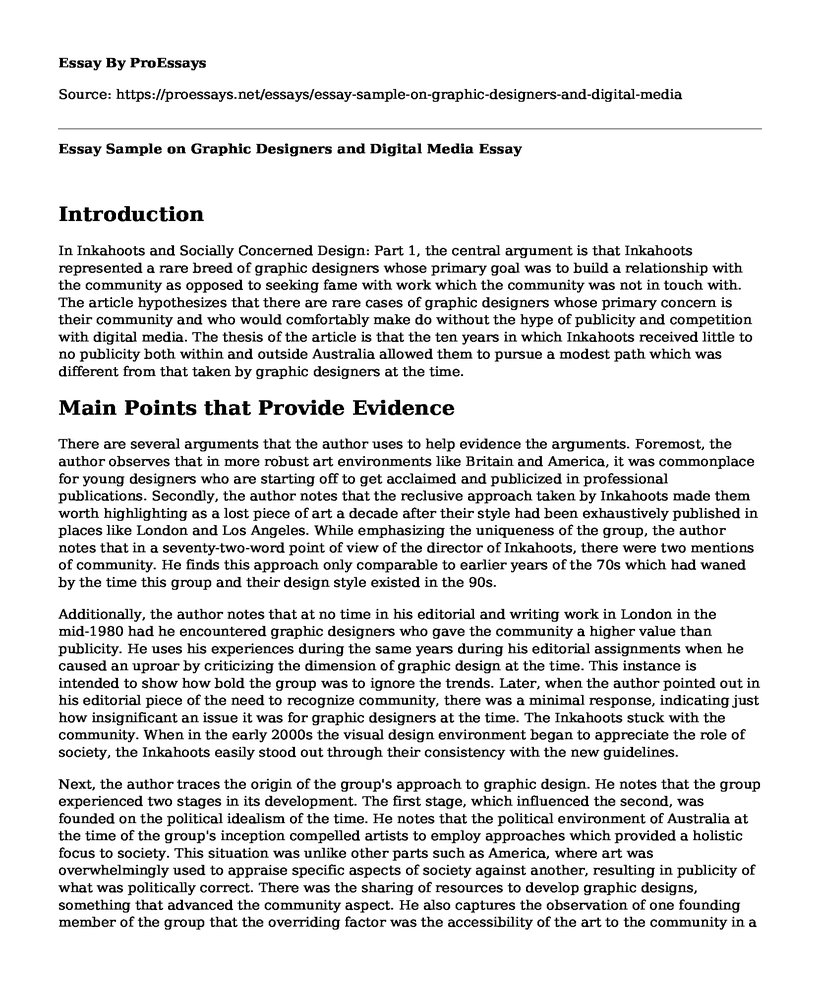Introduction
In Inkahoots and Socially Concerned Design: Part 1, the central argument is that Inkahoots represented a rare breed of graphic designers whose primary goal was to build a relationship with the community as opposed to seeking fame with work which the community was not in touch with. The article hypothesizes that there are rare cases of graphic designers whose primary concern is their community and who would comfortably make do without the hype of publicity and competition with digital media. The thesis of the article is that the ten years in which Inkahoots received little to no publicity both within and outside Australia allowed them to pursue a modest path which was different from that taken by graphic designers at the time.
Main Points that Provide Evidence
There are several arguments that the author uses to help evidence the arguments. Foremost, the author observes that in more robust art environments like Britain and America, it was commonplace for young designers who are starting off to get acclaimed and publicized in professional publications. Secondly, the author notes that the reclusive approach taken by Inkahoots made them worth highlighting as a lost piece of art a decade after their style had been exhaustively published in places like London and Los Angeles. While emphasizing the uniqueness of the group, the author notes that in a seventy-two-word point of view of the director of Inkahoots, there were two mentions of community. He finds this approach only comparable to earlier years of the 70s which had waned by the time this group and their design style existed in the 90s.
Additionally, the author notes that at no time in his editorial and writing work in London in the mid-1980 had he encountered graphic designers who gave the community a higher value than publicity. He uses his experiences during the same years during his editorial assignments when he caused an uproar by criticizing the dimension of graphic design at the time. This instance is intended to show how bold the group was to ignore the trends. Later, when the author pointed out in his editorial piece of the need to recognize community, there was a minimal response, indicating just how insignificant an issue it was for graphic designers at the time. The Inkahoots stuck with the community. When in the early 2000s the visual design environment began to appreciate the role of society, the Inkahoots easily stood out through their consistency with the new guidelines.
Next, the author traces the origin of the group's approach to graphic design. He notes that the group experienced two stages in its development. The first stage, which influenced the second, was founded on the political idealism of the time. He notes that the political environment of Australia at the time of the group's inception compelled artists to employ approaches which provided a holistic focus to society. This situation was unlike other parts such as America, where art was overwhelmingly used to appraise specific aspects of society against another, resulting in publicity of what was politically correct. There was the sharing of resources to develop graphic designs, something that advanced the community aspect. He also captures the observation of one founding member of the group that the overriding factor was the accessibility of the art to the community in a bid to bring about cohesion.
The dynamics of the group's second life stage cemented their consideration of community above personal fame. The author points out that in setting up after 1989, the group was required to have a constitution, be incorporated as a company, and have a committee. The group's consistent touch with the community was recognized, and for this recognition, it was easy for them to regard that as the foundation of their success. When the author visited the group's old operation base, posters remained intact, with all the themes captured in the highlighting social issues. Lastly, the author points out how the digital influence on how Australians viewed things and the loss of the sense of community changed the way that Inkahoots operated. As a result, they relocated their community setting materials and transferred to the city environment and chose to work from a studio.
Nodes and Links of the Arguments
The arguments are held together by nodes and links which the author chooses well for his advancement of the thesis. The first node captures the increased preference for publicity that began in the 1990s and has continued. The second node occurs at the point when the director of Inkahoots highlights that competing with modern trends is losing one's uniqueness. The third node is a reference to the anger of graphic designers of the 1990s on criticism of their approach. The next node captures the preference for attention as opposed to the substance by graphic designers during the time of the Inkahoots. Fifthly, there is mention of a successful attempt to revert to the old ways of graphic designing which gave the Inkahoots strength after years of consistency. Other nodes highlight the role of the political environment in shaping the approach used by the group, the distortion of cultural ideals through minimal consideration of substance, criticism of strategies that did not effectively highlight social issues and the impact of the experiences of group members in shaping their approach to graphic design.
Cite this page
Essay Sample on Graphic Designers and Digital Media. (2022, Dec 03). Retrieved from https://proessays.net/essays/essay-sample-on-graphic-designers-and-digital-media
If you are the original author of this essay and no longer wish to have it published on the ProEssays website, please click below to request its removal:
- Essay Sample on Exoticism
- Ideas of Appearance and Illusion in Othello Play Essay
- Research Paper on Types of Data Resources and How They Are Used at Amazon
- Essay Sample on A Computer Security Response Team
- Face of Lost Dream Film Essay Example
- Corporate Insider Threat Detection Paper Example
- Paper Sample on Cybersecurity in the UAE: Analyzing Threats, Techniques, Solutions







